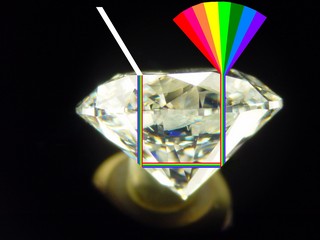Diamond color dispersion refers to the way light is split into its component colors (a phenomenon called “fire”) as it passes through a diamond. This optical effect is one of the key features that contribute to the visual beauty of a diamond, as it results in the appearance of colorful flashes or “rainbows” when the diamond is moved or light hits it at different angles.
How Color Dispersion Works:
Diamonds have a high refractive index (the measure of how much light is bent or refracted as it passes through the material), which is one of the reasons they sparkle so much. When light enters the diamond, it bends and slows down due to its high refractive index. As the light continues through the diamond, it is then dispersed or split into its component colors, creating the rainbow-like effect.
White light (from the sun or artificial sources) is composed of all colors in the spectrum, and the dispersion effect allows the diamond to separate these colors, showing them as flashes of red, orange, yellow, green, blue, indigo, and violet. The more intense and vivid these flashes, the higher the dispersion.
The degree of dispersion is largely influenced by the diamond’s cut and the quality of its facets. Diamonds that are cut to maximize the path of light through the stone tend to display stronger color dispersion.
Factors Affecting Diamond Color Dispersion:
Refractive Index: Diamonds have a refractive index of 2.42, which is high compared to many other gemstones. This contributes to their excellent ability to refract and disperse light.
Cut of the Diamond: The way a diamond is cut plays a significant role in its ability to disperse light. A well-cut diamond will have facets that are strategically placed to enhance the dispersion effect and maximize brilliance and fire. The angles and proportions of the cut are key factors in how light is channeled within the stone.
Diamond’s Dispersion Value: The dispersion of a diamond is measured by the difference in the refractive indices for red and violet light. Diamonds have a relatively high dispersion value, around 0.044, meaning they separate light into distinct colors. Some diamonds exhibit more noticeable “fire” or color dispersion than others, depending on their cut, size, and overall quality.
Fire and Brilliance in Diamonds:
Fire: The colorful flashes that appear due to dispersion are referred to as “fire.” A well-cut diamond with high dispersion can exhibit spectacular fire, especially when exposed to bright or varying light sources.
Brilliance: Brilliance refers to the white light that is reflected off a diamond’s facets. While dispersion creates colorful flashes, brilliance is the overall white sparkle you see from a well-cut diamond.
Comparison to Other Gemstones:
Diamonds have a higher dispersion than many other gemstones, like sapphires or emeralds, which is one of the reasons they are so visually striking.
Some gemstones, such as garnet or moissanite, have even higher dispersion values than diamonds, meaning they can display even more intense fire, but diamonds are still known for their exceptional balance of brilliance and fire.
Practical Implications for Diamond Buyers:
Fire and Visual Appeal: When selecting a diamond, many buyers are drawn to those that exhibit a strong fire effect due to higher dispersion. Diamonds that show flashes of vibrant color are often seen as more visually appealing.
Cut Quality: A diamond with a high degree of color dispersion is usually the result of an excellent cut. Poorly cut diamonds, even if they are of high quality, may not display the same fire due to improper light dispersion.
Summary:
Color dispersion is the splitting of light into its spectral colors, creating the characteristic “fire” in diamonds.
Diamond fire is a direct result of its dispersion ability, influenced by the diamond’s refractive index and cut.
Diamonds are renowned for their ability to exhibit color dispersion, contributing to their brilliance and visual allure.

